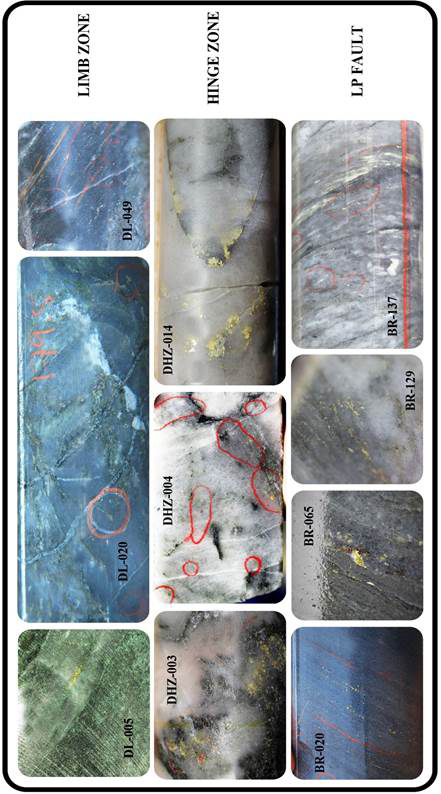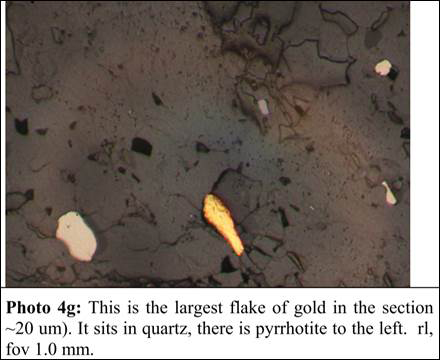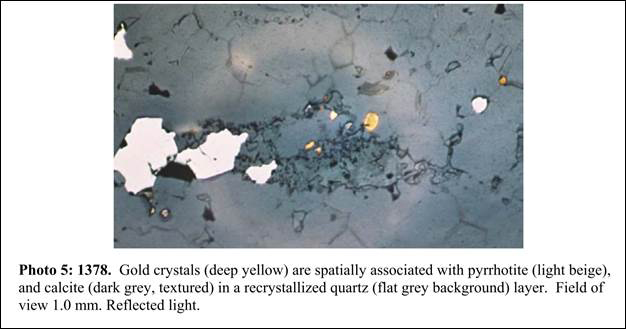Great Bear Provides Update on Metallurgical Testing
September 22, 2020
Vancouver, British Columbia, Canada – Great Bear Resources Ltd. (the "Company" or "Great Bear", TSX-V: GBR; OTCQX: GTBAF) today provided an update on metallurgical testing underway at its 100% owned flagship Dixie Project in the Red Lake district of Ontario.
Highlights Include:
- The Company has retained Blue Coast Research Ltd. from Parksville, British Columbia to provide metallurgical test work and consultation services for the Dixie Project.
- Metallurgical testing will provide the Company with estimates of likely gold recoveries, fineness, and recommendations on metallurgical flow sheet development and design for the various gold zones at the Dixie project, which are required for maiden resource publication.
- 7,465 occurrences of visible gold have been recorded in drill core to date by Great Bear. Over 80% of the Company’s drill holes into the LP Fault, Dixie Limb and Hinge zones have been noted to contain visible gold mineralization occurring as free gold and not bound to or within sulphide minerals. Examples are shown in Figure 1.
- In the Red Lake district, gold deposits that are similarly dominated by free gold typically yield very high gold recoveries. The primary example of this occurs at the Red Lake Gold Mine operated by Evolution Mining Ltd., where recoveries of 94 – 97% are typically reported (NI 43-101 Technical Report, Goldcorp, 2015).
- Samples from quartz veins, silica-sulphide replacement zones and disseminations within sedimentary and felsic host rocks from the LP Fault, Dixie Limb and Hinge zones have been, and continue to be, collected and submitted on an ongoing basis. Results will be released in batches as they are received.
- Early stage petrographic work completed by Great Bear and past operators provides key evidence of how gold occurs in the rocks, and is being used to guide metallurgical testing. This work has identified free gold mineralization at both the Dixie Limb and LP Fault Zones. Petrographic work on Hinge zone samples is underway and is expected to yield similar results.
- Great Bear has analyzed approximately 136,000 geochemical samples to date. Results suggest the gold mineralized system at Dixie generally has lower concentrations of trace elements such as arsenic, zinc and lead than are commonly observed within gold deposits across the Red Lake district, due to a lower content of accessory sulphide minerals. Other elements such as antimony and tellurium are also generally absent in the mineralized zones at Dixie.
Chris Taylor, President and CEO of Great Bear said, “We have catalogued over seven thousand occurrences of free visible gold in our drill core to date. In more than 99% of observed instances, gold occurs freely or on the edges of sulphide grains, suggesting potential for very high metallurgical recoveries, as has been observed at other free gold hosting deposits in the Red Lake district. This is reinforced by petrographic studies which show the same unencapsulated gold at microscope scale. We are therefore very optimistic about the high recovery potential for gold from all of our mineralized zones, and will provide results from metallurgical testing on an ongoing basis as these become available.”
Preliminary Metallurgical Analysis: Petrography
Metallurgical petrography involves the examination of thin sections of gold-hosting rock under a microscope to determine whether the gold occurs freely within silicate minerals (such as within quartz veins), where it is likely to require simpler processes to extract, or alternatively is bound within sulphide minerals, where more complicated extraction processes may be required.
Petrographic work by Great Bear and past operators confirms that gold at the Dixie project occurs freely in association with silicate minerals and is not encapsulated by sulphide mineral species, even when sulphide accessory minerals are present.
LP Fault Zone
2019 research conducted by Panterra Geoservices Inc. (“Panterra”) on behalf of Great Bear described gold bearing samples from the LP Fault zone as follows:
“…Several flakes of gold are present and all appear to lie within the same dismembered folia of interlocking quartz…The largest flake is around 0.2 mm and the flakes are visible with a hand lens. Some of the flakes are touching biotite or calcite. They are not associated with the cubic pyrite.”
A photomicrograph image of this gold mineralization is provided in Figure 2.
Dixie Limb Zone
A similar historical report completed in 2004 by Panterra on behalf of a past operator included optical petrography and scanning electron microscope (SEM) examination of gold mineralization from the Dixie Limb zone, where sulphide minerals dominated by pyrrhotite frequently accompany gold mineralization. The report concluded:
“…Several crystals [of gold] were attached to the edge of larger pyrrhotite crystals, but none was encapsulated.”
A photomicrograph image of this gold mineralization is provided in Figure 3.
Petrographic and metallurgical sampling and analysis are also underway at the Hinge zone. Based on more than one thousand in-core visible gold observations made to date, the Company expects similar results to those which have been reported from the LP Fault and Dixie Limb.
Figure 1: Examples of free gold in drill core from the Dixie Limb, Hinge and LP Fault zones. This is the dominant format of gold mineralization within these gold zones. Images are of selected core intervals and do not represent all of the gold mineralization at Dixie.

Figure 2: Free gold (yellow) within a sample from the LP Fault which assayed 130.97 g/t gold (Ross, 2019).

Figure 3: Petrographic report completed in 2004 by Fronteer Gold Corp. showing free gold (yellow) from the Dixie Limb zone (Ross, 2004).

About the Dixie Project
The Dixie Project is 100% owned, comprised of 9,140 hectares of contiguous claims that extend over 22 kilometres, and is located approximately 25 kilometres southeast of the town of Red Lake, Ontario. The project is accessible year-round via a 15 minute drive on a paved highway which runs the length of the northern claim boundary and a network of well-maintained logging roads.
The Dixie Project hosts two principle styles of gold mineralization:
- High-grade gold in quartz veins and silica-sulphide replacement zones (Dixie Limb, Hinge and Arrow zones). Hosted by mafic volcanic rocks and localized near regional-scale D2 fold axes. These mineralization styles are also typical of the significant mined deposits of the Red Lake district.
- High-grade disseminated gold with broad moderate to lower grade envelopes (LP Fault). The LP Fault is a significant gold-hosting structure which has been seismically imaged to extend to 14 kilometres depth (Zeng and Calvert, 2006), and has been interpreted by Great Bear to have up to 18 kilometres of strike length on the Dixie property. High-grade gold mineralization is controlled by structural and geological contacts, and moderate to lower-grade disseminated gold surrounds and flanks the high-grade intervals. The dominant gold-hosting stratigraphy consists of felsic sediments and volcanic units.
About Great Bear
Great Bear Resources Ltd. is a well-financed gold exploration company managed by a team with a track record of success in mineral exploration. Great Bear is focused in the prolific Red Lake gold district in northwest Ontario, where the company controls over 300 km2 of highly prospective tenure across 4 projects: the flagship Dixie Project (100% owned), the Pakwash Property (earning a 100% interest), the Dedee Property (earning a 100% interest), and the Sobel Property (earning a 100% interest), all of which are accessible year-round through existing roads.
Qualified Person and NI 43-101 Disclosure
Mr. R. Bob Singh, P.Geo, Director and VP Exploration, and Ms. Andrea Diakow P.Geo, Exploration Manager for Great Bear are the Qualified Persons as defined by National Instrument 43-101 responsible for the accuracy of technical information contained in this news release.
ON BEHALF OF THE BOARD
“Chris Taylor
Chris Taylor, President and CEO
Investor Inquiries:
Mr. Knox Henderson
Tel: 604-646-8354
Direct: 604-551-2360
info@greatbearresources.ca
www.greatbearresources.ca
Cautionary note regarding forward-looking statements
This release contains certain “forward looking statements” and certain “forward-looking information” as defined under applicable Canadian and U.S. securities laws. Forward-looking statements and information can generally be identified by the use of forward-looking terminology such as “may”, “will”, “should”, “expect”, “intend”, “estimate”, “anticipate”, “believe”, “continue”, “plans” or similar terminology. The forward-looking information contained herein is provided for the purpose of assisting readers in understanding management’s current expectations and plans relating to the future. Readers are cautioned that such information may not be appropriate for other purposes.
Forward-looking information are based on management of the parties’ reasonable assumptions, estimates, expectations, analyses and opinions, which are based on such management’s experience and perception of trends, current conditions and expected developments, and other factors that management believes are relevant and reasonable in the circumstances, but which may prove to be incorrect.
Great Bear undertakes no obligation to update forward-looking information except as required by applicable law. Such forward-looking information represents management's best judgment based on information currently available. No forward-looking statement can be guaranteed and actual future results may vary materially. Accordingly, readers are advised not to place undue reliance on forward-looking statements or information.

